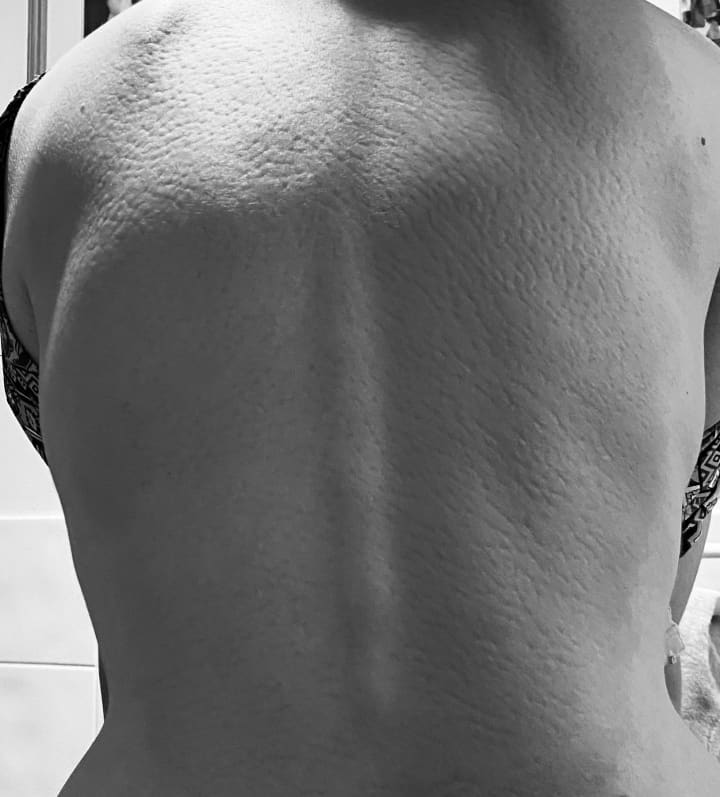
Browser History:
Is it weird that Facebook knows we’re in pain?
And how do they do it? Is there some sort of algorithm that correlates with an increase in mindless scrolling from the foetal position? Maybe the timing- increased Facebook use in those sleepless hours in the small of the morning? Or is it an improvement in facial recognition technology? Like the kind friend who notices that you look ‘tired’? Thanks- I’m in chronic pain.
I don’t think it’s a stretch to say that Facebook knew I had endometriosis before I got the definitive diagnosis. And by golly, once they knew, did they throw themselves wholeheartedly into attempting to solve my problem! ‘This hormone supplement...’, ‘...the electrical impulses simply put a stop to pain!’, ‘...this app really changed my life!’
I like to call myself a skeptic, and to believe that I’m not easily influenced by advertising, but supplements, tens machines, mindfulness apps- these were all things that I would eventually try, in one form or another. I tend to think that scrolling past targeted advertising whilst in pain is the digital equivalent of walking the confectionary aisle after skipping lunch- sometimes that temptation is just too great. That said, a Snickers bar at 3pm can ‘really satisfy’, at least for a time, and the desperation of chronic illness can make even a mild improvement in symptoms worth the money (and the upswing in ads you’re exposed to- ‘if you liked this supplement, you’ll love this one too!’).
It was a combination of the Facebook-in-lieu-of-sleep scenario that I alluded to earlier, my ‘candy aisle’ theory and repeated exposure to a concentration of targeted advertisement that led to my greatest online purchase so far. Something that actually worked. Something that I had scrolled past perhaps a hundred times, but that in my moment of vulnerability called to me, a Siren’s song to PayPal. And here’s the kicker- it was technology that had been available to me (ok, so not to me personally, but to those suffering from pain), for several hundred years at least.
Ancient History:
No, I’m not joking. What I’d purchased was a bed of nails. Albeit, not quite the model from the Wikipedia article above! This was a bed of nails for the 21st century- plastic spikes (6000 of them in fact) on a padded base. This was the Shakti Mat.
Playing on an ‘ancient healing technique’ ‘2000 years’ in the making, as stated on the Shakti Mat website, the premise lies in acupressure- alternative medicine harnessing life energy flowing through the body by activating trigger points. I know. I know what you’re thinking. Look- I’m a medical professional myself, so yes, I am a natural skeptic in these areas too. Prior to trying the Shakti Mat, the mention of a bed of nails would have led me back to High School physics classes, understanding that the distribution of weight over the thousands of sharp points prevents any one point from tearing the skin. I’d imagine images like the ones in the Wikipedia article linked above- I knew there was a historical use in meditation, just as there had been in showmanship. Roll up! Roll up! See the amazing man with the elephant’s skin- lying on a bed of nails. See how we place a block of concrete on his chest- still, his skin does not tear!
Yes, I was a skeptic. There’s well and truly enough usage of the terms ‘no reliable evidence’ and ‘likelihood of bias’ on the acupressure Wikipedia page alone to turn me off making a recommendation on any scientific basis. But what I can say to you is the same thing I said to myself, late at night in the throes of tremendous, insurmountable pain, with my finger hovering over the add to cart button. ‘It’s worth a try’.
My History:
The night that I ordered the Shakti Mat I was actually in hospital. 9 days prior I had finally gone ahead with abdominal surgery, confirming my endometriosis and aiming to reduce the visible portions of it. In the intervening time I had re-presented to the hospital as an emergency, and been hospitalised for a week. Sites where my internal organs had formed abnormal adhesions to one-another, and to my abdominal wall, which were broken down during the surgery, had then haemorrhaged. Internal bleeding. Almost funny that this internal bleeding was taken seriously, when I had been bleeding internally for so many years.
Like most endometriosis sufferers, the road to diagnosis was long and paved with dismissive professionals. From my first period I had issues. The first time, the very first time, I bled through tights and my woollen winter uniform onto a seat in choir practice. When the instructor asked us to change seats, I couldn’t- I was mortified. I was eleven. That year I fainted into a brick wall in the girls’ toilets and sustained a black eye. My teacher was male, it was 2003, a conservative Christian school- it was taboo to tell him why when he asked how I got it. It was the year of the Khaki Shorts Incident. Hauled into the air in a harness on school camp, my crush at the front of the team on the rope, and I could feel it. Light coloured khaki shorts, viewed from below. How I wish I could tell my crush that I’ve gotten over it now, if I ever ran into him. What a lie that would be. At the doctor, my mother was told that the reason I asked to stay home, claiming extreme cramps and an ever-present risk of passing out, was not medical- I was probably being bullied.
By the age of 15 the word endometriosis had been mentioned by one medical professional, right before starting me on the pill. I had attended the appointment because I needed a way to skip my periods. I had been selected for an exchange, and I couldn’t imagine how, in a foreign country, grasping for the dialect to explain, I would be able to suffer them.
It all came to a head in my final year of veterinary school. Working what were often 14 hour days, moving around the country to different clinics at the whim of the school, I missed an appointment necessary for a repeat prescription, so took myself off the pill for the first time in 8 years. It was the headaches first. Literally blinding. Pain- mostly back pain at that time, leg pain, calf cramps in the night. The fatigue. The fatigue was terrible. I would often need to leave the supermarket mid-shop to sit on the seat out the front. It was every day, not only at the time of my period. It was so easy to pass off as the stress of final year, but it persisted beyond graduation, and beyond the weeks I had originally planned to take off prior to job hunting. 2015, my first year out of uni, turned into a year of medical appointments, fruitless testing, debilitation in even every-day tasks. My doctor gave me the twin diagnoses of chronic fatigue and fibromyalgia, born of an inability to identify anything else, and the intimation that perhaps I wasn’t ‘cut out to be a veterinarian’. Those words exactly. A hard-won dream since the age of four that had come to this.
Every job interview I attended thereafter probed into my short absence from the profession. ‘Medical reasons’ wouldn’t satiate. (Illegally) the probing would continue until I admitted chronic fatigue. I would watch the word ‘unreliable’ form in the head of the interviewer. It was heartbreak over and over. But I did find a job in the end, in happenstance, perhaps the best I could have. Then the abdominal pain began. Every day. And it was bad. A change in doctor, all the tests, repeated. Finally, 2019, a referral, the surgery, the confirmation. A sense of… validation? But now the firm knowledge of a chronic, incurable disease. And complications from the surgery, leaving me worse-off than before it. Emotional turmoil, hospital grade analgesics but pain none-the-less, and an inability to sleep. Was I the perfect consumer to scroll along to a Shakti Mat ad? You bet I was.
When it first arrived in the post, I had actually forgotten I’d ordered it. It was among several things I had bought in my semi-delirious state, but it was certainly more intriguing than the undersized linen pants or the T-shirt sporting a big black cat (I saw a cat through the hospital window, I remembered, and I took it as a sign to buy the shirt. A perfect consumer indeed).
For my first use of the Shakti Mat I followed the advice of the website intended to ease a user into the sensation. On a soft surface (my bed), clothes between me and the mat. But my curiosity for the full effect quickly got the better of me. I saw the photos of people, their bare skin red and indented as they rose from a session on the mat, and some primal urge told me I needed that. Was it masochism? Not exactly. With constant pain of the variety that I knew, it wasn’t an entirely pleasant prospect to invite more. Yet something told me that it would work. And it did. From that first session. Twenty minutes on the mat, with bare skin, the mat positioned to focus on my lower back, from which my abdominal pain radiates, and that feeling of being violently harpooned began to dissipate. No longer harpooned, but hooked.

The Shakti Mat has now become a regular part of my routine. I can’t claim any lasting pain relief once I’m off it, but for the time that I use it, it works wonders. I find it so relaxing that I often fall asleep on the mat (a wonder in itself when pain would often otherwise preclude sleep, but an experience I wouldn’t recommend- unpeeling oneself from the mat after several hours rather than the recommended 20 minutes is more than a little unpleasant). I have never experienced any damage to my skin- after a session you can feel the small indents over the surface exposed to the spikes (trypophobes look away!), and the skin becomes warm and even slightly itchy for a few minutes afterwards, but this has never lasted.

TLDR: The Shakti Mat is worth a try for anyone experiencing long term pain, especially of the lower or upper back. For endometriosis sufferers I give a particular recommendation.
According to the Shakti Mat website, the mats are ethically manufactured with humanitarian aid in mind, and support missions such as the provision of mosquito nets to children in areas affected by malarial disease. So what’s not to like? I even purchased one as a gift (though ended up keeping it myself- mat number two in what might become quite a collection). Originally intended for my boyfriend, when COVID temporarily put us into an enforced long distance relationship I found the temptation of trialling the ‘Advanced’ Shakti Mat too great and opened it up. A terrible crime, but I would commit it again, and in the meantime you can find me blissfully pain free, relaxing on my Shakti Mat and scrolling through Facebook.
I wonder what ad I’ll encounter today?
March just happens to be Endometriosis Awareness Month- a perfect opportunity to discuss this disease and the various ways those affected can seek some relief. For more information I recommend https://www.endometriosisaustralia.org/
You can check out the Shakti Mat for yourself at https://www.shaktimats.com.au/pages/why-buy-shakti, but let’s be real: you know that targeted advertising is about to hit you anyway!






Comments
There are no comments for this story
Be the first to respond and start the conversation.